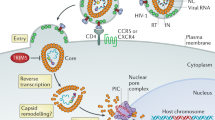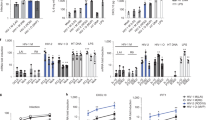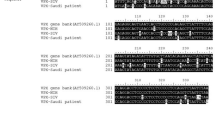Abstract
Host cell barriers to the early phase of immunodeficiency virus replication explain the current distribution of these viruses among human and non-human primate species1,2,3,4. Human immunodeficiency virus type 1 (HIV-1), the cause of acquired immunodeficiency syndrome (AIDS) in humans, efficiently enters the cells of Old World monkeys but encounters a block before reverse transcription2,3,4. This species-specific restriction acts on the incoming HIV-1 capsid5,6,7 and is mediated by a dominant repressive factor7,8,9. Here we identify TRIM5α, a component of cytoplasmic bodies, as the blocking factor. HIV-1 infection is restricted more efficiently by rhesus monkey TRIM5α than by human TRIM5α. The simian immunodeficiency virus, which naturally infects Old World monkeys10, is less susceptible to the TRIM5α-mediated block than is HIV-1, and this difference in susceptibility is due to the viral capsid. The early block to HIV-1 infection in monkey cells is relieved by interference with TRIM5α expression. Our studies identify TRIM5α as a species-specific mediator of innate cellular resistance to HIV-1 and reveal host cell components that modulate the uncoating of a retroviral capsid.
This is a preview of subscription content, access via your institution
Access options
Subscribe to this journal
Receive 51 print issues and online access
$199.00 per year
only $3.90 per issue
Buy this article
- Purchase on Springer Link
- Instant access to full article PDF
Prices may be subject to local taxes which are calculated during checkout




Similar content being viewed by others
References
LaBonte, J., Babcock, G., Patel, T. & Sodroski, J. Blockade of human immunodeficiency virus (HIV-1) of New World monkey cells occurs primarily at the stage of virus entry. J. Exp. Med. 196, 431–435 (2002)
Shibata, R., Sakai, H., Kawamura, M., Tokunaga, K. & Adachi, A. Early replication block of human immunodeficiency virus type 1 in monkey cells. J. Gen. Virol. 76, 2723–2730 (1995)
Himathongkham, S. & Luciw, P. A. Restriction of HIV-1 (subtype B) replication at the entry step in rhesus macaque cells. Virology 219, 485–488 (1996)
Hofmann, W. et al. Species-specific, postentry barriers to primate immunodeficiency virus infection. J. Virol. 73, 10020–10028 (1999)
Owens, C. M., Yang, P. C., Gőttlinger, H. & Sodroski, J. Human and simian immunodeficiency virus capsid proteins are major viral determinants of early, post-entry replication blocks in simian cells. J. Virol. 77, 726–731 (2003)
Kootstra, N. A., Munk, C., Tonnu, N., Landau, N. R. & Verma, I. M. Abrogation of postentry restriction of HIV-1 based lentiviral vector transduction in simian cells. Proc. Natl Acad. Sci. USA 100, 1298–1303 (2003)
Cowan, S. et al. Cellular inhibitors with Fv-1-like activity restrict human and simian immunodeficiency virus tropism. Proc. Natl Acad. Sci. USA 99, 11914–11919 (2002)
Besnier, C., Takeuchi, Y. & Towers, G. Restriction of lentivirus in monkeys. Proc. Natl Acad. Sci. USA 99, 11920–11925 (2002)
Munk, C., Brandt, S. M., Lucero, G. & Landau, N. R. A dominant block to HIV-1 replication at reverse transcription in simian cells. Proc. Natl Acad. Sci. USA 99, 13843–13848 (2002)
Kanki, P. J., Alroy, J. & Essex, M. Isolation of T-lymphotropic retrovirus related to HTLV-III/LAV from wild-caught African green monkeys. Science 230, 951–954 (1985)
Reddy, B. A., Etkin, L. D. & Freemont, P. S. A novel zinc finger coiled-coil domain in a family of nuclear proteins. Trends Biochem. Sci. 17, 344–345 (1992)
Borden, K. L. RING fingers and B-boxes: zinc-binding protein–protein interaction domains. Biochem. Cell Biol. 76, 351–358 (1998)
Reymond, A. et al. The tripartite motif family identifies cell compartments. EMBO J. 20, 2140–2151 (2001)
Xu, L. et al. BTBD1 and BTBD2 colocalize to cytoplasmic bodies with the RBCC/tripartite motif protein, TRIM5δ. Exp. Cell Res. 288, 84–93 (2003)
Feng, Y., Broder, C. C., Kennedy, P. E. & Berger, E. A. HIV-1 entry co-factor: functional cDNA cloning of a seven-transmembrane, G protein-coupled receptor. Science 272, 872–877 (1996)
Li, J., Lord, C. I., Haseltine, W., Letvin, N. L. & Sodroski, J. Infection of cynomolgus monkeys with a chimeric HIV-1/SIVmac virus that expresses the HIV-1 envelope glycoproteins. J. AIDS 5, 639–646 (1992)
Dorfman, T. & Gőttlinger, H. G. The human immunodeficiency virus type 1 capsid p2 domain confers sensitivity to the cyclophilin-binding drug SDZ NIM 811. J. Virol. 70, 5751–5757 (1996)
Waterman, H., Levkowitz, G., Alroy, I. & Yarden, Y. The RING finger of c-CBL mediates desensitization of the epidermal growth factor receptor. J. Biol. Chem. 274, 22151–22154 (1999)
Owens, C. M. et al. Binding and susceptibility to post-entry restriction factors in monkey cells are specified by distinct regions of the human immunodeficiency virus type 1 capsid. J. Virol. (in the press)
Fassati, A. & Goff, S. P. Characterization of intracellular reverse transcription complexes of human immunodeficiency virus type 1. J. Virol. 75, 3626–3635 (2001)
Forshey, B. M., von Schwedler, U., Sundquist, W. I. & Aiken, C. Formation of a human immunodeficiency virus type 1 core of optimal stability is crucial for viral replication. J. Virol. 76, 5667–5677 (2002)
Schwartz, O., Maréchal, V., Friguet, B., Arenzana-Seisdedos, F. & Heard, J.-M. Antiviral activity of the proteasome on incoming human immunodeficiency virus type 1. J. Virol. 72, 3845–3850 (1998)
Turelli, P. et al. Cytoplasmic recruitment of INI1 and PML on incoming HIV preintegration complexes: interference with early steps of viral replication. Mol. Cell 7, 1245–1254 (2001)
Marcello, A. et al. Recruitment of human cyclin T1 to nuclear bodies through direct interaction with the PML protein. EMBO J. 22, 2156–2166 (2003)
Bonilla, W. V. et al. Effects of promyelocytic leukemia protein on virus-host balance. J. Virol. 76, 3810–3818 (2002)
Chee, A. V., Lopez, P., Pandolfi, P. P. & Roizman, B. Promyelocytic leukemia protein mediates interferon-based anti-herpes simplex virus 1 effects. J. Virol. 77, 7101–7105 (2003)
Rhodes, D. A. et al. The 52,000 MW Ro/SS-A autoantigen in Sjogren's syndrome/systemic lupus erythematosus (Ro52) is an interferon-γ inducible tripartite motif protein associated with membrane proximal structures. Immunology 106, 246–256 (2002)
Toniato, E. et al. TRIM8/GERP RING finger protein interacts with SOCS-1. J. Biol. Chem. 277, 37315–37322 (2002)
Mariani, R. et al. Species-specific exclusion of APOBEC3G from HIV-1 virions by Vif. Cell 114, 21–31 (2003)
Butler, S., Hansen, M. S. T. & Bushman, F. A quantitative assay for HIV DNA integration in vivo. Nature Med. 7, 631–634 (2001)
Acknowledgements
We thank S. Farnum and Y. McLaughlin for manuscript preparation; and S. Basmaciogullari, R. Lu, N. Vandegraaff and A. Engelman for advice and reagents. This work was supported by grants from the NIH, by a Center for AIDS Research Award, by the International AIDS Vaccine Initiative, and by the Bristol-Myers Squibb Foundation. M.S. is supported by a National Defense Science and Engineering Fellowship and is a Fellow of the Ryan Foundation.
Author information
Authors and Affiliations
Corresponding author
Ethics declarations
Competing interests
The authors declare that they have no competing financial interests.
Supplementary information
Supplementary Figure 1
TRIM5αrh restricts infectious HIV-1 replication at an increased multiplicity of infection. (PDF 50 kb)
Supplementary Figure 2
Effects of the HA tag on the ability of human and rhesus TRIM5α to restrict virus infection. (PDF 64 kb)
Supplementary Figure 3
Interference with TRIM5αrh expression in rhesus kidney cells relieves the post-entry restriction to HIV-1. (PDF 79 kb)
Rights and permissions
About this article
Cite this article
Stremlau, M., Owens, C., Perron, M. et al. The cytoplasmic body component TRIM5α restricts HIV-1 infection in Old World monkeys. Nature 427, 848–853 (2004). https://doi.org/10.1038/nature02343
Received:
Accepted:
Issue Date:
DOI: https://doi.org/10.1038/nature02343
This article is cited by
-
Are dogs not susceptible to retroviral infections?
Animal Diseases (2023)
-
Primate TRIM34 is a broadly-acting, TRIM5-dependent lentiviral restriction factor
Retrovirology (2023)
-
Epigenome-wide association study identifies novel genes associated with ischemic stroke
Clinical Epigenetics (2023)
-
Interleukin-22 facilitates the interferon-λ-mediated production of tripartite motif protein 25 to inhibit replication of duck viral hepatitis A virus type 1
Veterinary Research (2023)
-
TRIM26 positively affects hepatitis B virus replication by inhibiting proteasome-dependent degradation of viral core protein
Scientific Reports (2023)
Comments
By submitting a comment you agree to abide by our Terms and Community Guidelines. If you find something abusive or that does not comply with our terms or guidelines please flag it as inappropriate.



